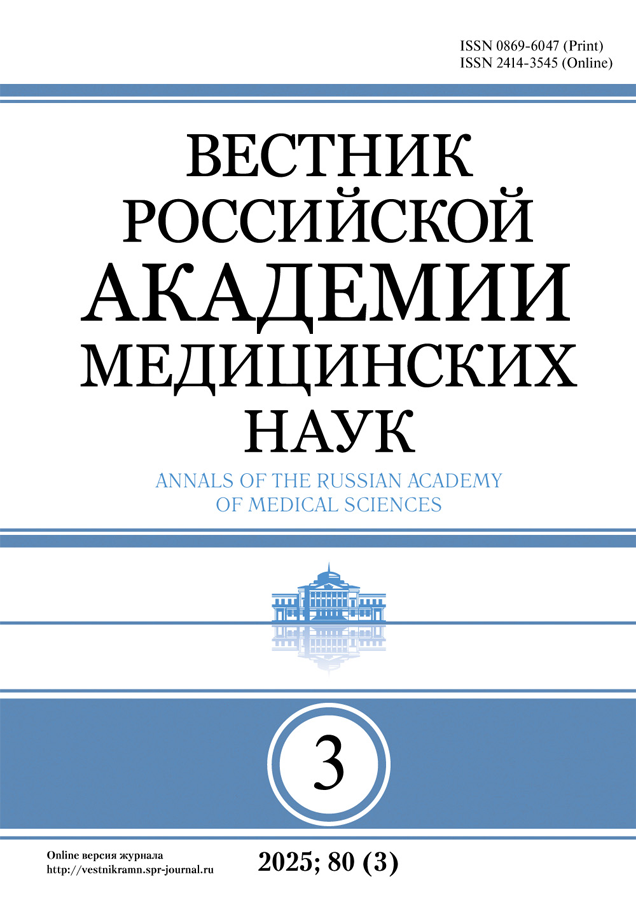МОЛЕКУЛЯРНЫЕ МЕХАНИЗМЫ ФОРМИРОВАНИЯ ЭОЗИНОФИЛИИ КРОВИ ПРИ ТУБЕРКУЛЕЗЕ ЛЕГКИХ
- Авторы: Колобовникова Ю.В.1, Уразова О.И.1, Новицкий В.В.1, Михеева К.О.1, Гончаров М.Д.1
-
Учреждения:
- ГБОУ ВПО «Сибирский государственный медицинский университет» Минздравсоцразвития России, Томск
- Выпуск: Том 67, № 5 (2012)
- Страницы: 58-62
- Раздел: КРАТКИЕ СООБЩЕНИЯ
- Дата публикации: 23.05.2012
- URL: https://vestnikramn.spr-journal.ru/jour/article/view/306
- DOI: https://doi.org/10.15690/vramn.v67i5.276
- ID: 306
Цитировать
Полный текст
Аннотация
В статье проанализированы молекулярные факторы патогенеза эозинофильной реакции крови при туберкулезе легких. Установлено, что ключевым цитокином, обусловливающим развитие гемической эозинофилии при туберкулезе легких, является интерлейкин-5 (IL-5), концентрация которого в сыворотке крови оказалась повышенной только у пациентов с эозинофилией. Увеличение содержания эотаксина, как сопровождающееся эозинофилией, так и без нее, было зарегистрировано в сыворотке крови у больных туберкулезом., Однонаправленный характер обнаруженных изменений содержания эотаксина связан с двойственностью свойств данного хемокина: с одной стороны, эотаксин опосредует пролонгированное пребывание эозинофилов в кровотоке, а с другой — инициирует процесс адгезии эозинофильных лейкоцитов к эндотелию сосудов с последующей их миграцией в очаг гранулематозного воспаления. Установленное увеличение числа IL-5R-позитивных эозинофилов является еще одним механизмом, лежащим в основе длительного пребывания эозинофилов в периферической крови при туберкулезе легких.
Ключевые слова
Об авторах
Ю. В. Колобовникова
ГБОУ ВПО «Сибирский государственный медицинский университет»Минздравсоцразвития России, Томск
Автор, ответственный за переписку.
Email: kolobovnikova.julia@mail.ru
кандидат медицинских наук, ассистент кафедры патофизиологии ГБОУ ВПО СибГМУ Минздравсоцразвития России, Адрес: 634050, Томск, Московский тракт, д. 2 Тел.: (3822) 55-36-13 Россия
О. И. Уразова
ГБОУ ВПО «Сибирский государственный медицинский университет»Минздравсоцразвития России, Томск
Email: urazova72@yandex.ru
доктор медицинских наук, профессор кафедры патофизиологии ГБОУ ВПО СибГМУ Минздравсоцразвития России Адрес: 634050, Томск, Московский тракт, д. 2 Тел.: (3822) 55-36-13 Россия
В. В. Новицкий
ГБОУ ВПО «Сибирский государственный медицинский университет»Минздравсоцразвития России, Томск
Email: office@ssmu.net.ru
академик РАМН, профессор, заведующий кафедрой патофизиологии ГБОУ ВПО СибГМУ Минздравсоцразвития России Адрес: 634050, Томск, Московский тракт, д. 2 Тел.: (3822) 55-36-13 Россия
К. О. Михеева
ГБОУ ВПО «Сибирский государственный медицинский университет»Минздравсоцразвития России, Томск
Email: mko1986@sibmail.com
аспирант кафедры патофизиологии ГБОУ ВПО СибГМУ Минздравсоцразвития России Адрес: 634050, Томск, Московский тракт, д. 2 Тел.: (3822) 55-36-13 Россия
М. Д. Гончаров
ГБОУ ВПО «Сибирский государственный медицинский университет»Минздравсоцразвития России, Томск
Email: mko1986@sibmail.com
студент 6-го курса медико-биологического факультета ГБОУ ВПО СибГМУ Минздравсоцразвития России Адрес: 634050, Томск, Московский тракт, д 2 Тел.: (3822) 55-36-13 Россия
Список литературы
- VoronLova O.V., Urazova O.I., NovitcLii` V.V., Strelis A.K. Immunopatologiia tuberLuleza legLikh. Tomsq: Izd-vo Tom. un-ta. 2007. 194 s.
- Kirman J. Role of eosinophils in the pathogenesis of Mycobacterium bovis BCG infection in gamma interferon receptor-deficient mice. Infect. Immun. 2009; 68 (5): 2976–2978.
- Lasco T.M. Rapid Accumulation of Eosinophils in Lung Lesions in Guinea Pigs Infected with Mycobacterium tuberculosis. Infect. Immun. 2004; 72 (2): 1147–1149.
- -JUWJOPWB - 4 3ZB[BOUTFWB / 7 /PWJUTLJJ 7 7 ,MFUPDIOZF NF LIBOJ[NZ bol`shikh eozinofilii` Lrovi. TomsL: Izd-vo Tom. un-ta. 2007. 138 s.
- Mordvinov V.A., Furman D.P. TDitoLiny`: biologichesLie svoi`stva i reguliatciia eLspressii gena interleiLina-5 cheloveLa. 7FTUOJL VOGiS. 2009; 13 (1): 53–67.
- Hogan S.P. Eosinophils: Biological Properties and Role in Health and Disease. Clinical & Experimental Allergy. 2008; 38: 709–750.
- Liadova I.V., Gergert V.Ia. Reaqtcii T-Lletochnogo immuniteta pri tuberLuleze: eLsperimental`ny`e i LlinichesLie issledovaniia. Tuberqulez i bolezni legqikh. 2009; 11: 9–18.
- Barnes P.J. Differential regulation of human eosinophil IL-3, IL-5, and GM-CSF receptor alpha-chain expression by cytokines. J. Immunol. 2003; 1 (5): 167–175.
- Nagase H., Miyamasu M., Yamaguchi M. Regulation of chemokine receptor expression in eosinophils. Arch. Allergy Immunol. 2001; 1 (10): 29–32.
- Mordvinov V.A., Sanderson C.J. Regulation of IL-5 expression. Arch. Immunol. Ther. Exp. (Warsz). 2001; 5 (1): 345–351.
- Garcia-Zepeda E.A., Rothenberg M.E., Ownbey R.T. et al. Human eotaxin is a specific chemoattractant for eosinophil cells and provides a new mechanism to explain tissue eosinophilia. Nat. Med. 1996; 2: 449–456.
- Jose P.J., Griffiths-Johnson D.A., Collins P.D. et al. Eotaxin: a potent eosinophil chemoattractant cytokine detected in a guinea pig model of allergic airways inflammation. J. Exp. Med. 1994; 179: 881–887.
- Fulkerson P.C., Fischetti C.A., Rothenberg M.E. Eosinophils and CCR3 regulate interleukin-13 transgene-induced pulmonary remodeling. Am. J. Pathol. 2006; 169 (6): 2117–2126.
- Park Y.M., Bochner B.S. Eosinophil Survival and Apoptosis in Health and Disease. Allergy Asthma Immunol. Res. 2010, 2 (2): 87–101.
- Tavernier J., Devos R., Cornelis S.et al. A human high affinity interleukin-5 receptor (IL5R) is composed of an IL5-specific α-chain and a β chain shared with the receptor for GM-CSF. Cell. 2001; 66 (7): 1175
Дополнительные файлы








